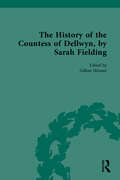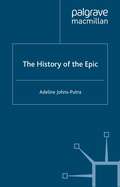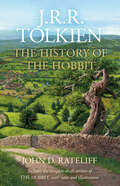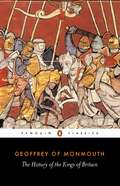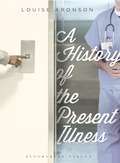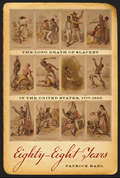- Table View
- List View
A History of the Booker Prize: Contemporary Fiction Since 1992
by Merritt MoseleyIn this book, Merritt Moseley offers a brief history of the Booker Prize since 1992. With a short chapter covering each year, we follow the change in criteria, the highs and lows, short lists, winners, and controversies of the Booker Prize. The book also functions as an example of literary criticism for each of the books involved, analyzing the judging process and the winning books. Exploring themes such as literary vs. popular fiction, the role of Postcolonial work in what began as a very "British" prize, the role of marketing, publishing, and the Booker organization itself, the book offers a crucial view into literary prize culture. The book spends time looking at exclusions, as well as the overall role and function of the literary prize. What books aren’t included and why? Why has the Booker become so significant? This book will be of use to anyone with an interest in, or studying, contemporary literature, literary prizes, literary culture and British literature, as well as publishing studies.
The History of the Countess of Dellwyn, by Sarah Fielding (Chawton House Library: Women's Novels)
by Gillian SkinnerSarah Fielding was one of the most respected women authors of her generation and a key figure in the development of the novel. She was admired especially by Samuel Richardson, who famously commented that her ‘knowledge of the human heart’ was greater than that of her brother, the novelist Henry Fielding. This edition revives The Countess of Dellwyn, the only one of Sarah Fielding’s major works not previously available in a modern scholarly edition. The novel is satirical and didactic, taking as its targets fashionable life and modern marriage (and scandalous divorce) and narrated with acerbic wit by its anonymous third-person narrator. This edition benefits greatly from Gillian Skinner’s editorial work and it is a book that will be of great interest to researchers into the eighteenth-century novel and women’s writing of the period worldwide.
The History of the Countess of Dellwyn, by Sarah Fielding (Chawton House Library: Women's Novels)
by Gillian SkinnerSarah Fielding was one of the most respected women authors of her generation and a key figure in the development of the novel. She was admired especially by Samuel Richardson, who famously commented that her ‘knowledge of the human heart’ was greater than that of her brother, the novelist Henry Fielding. This edition revives The Countess of Dellwyn, the only one of Sarah Fielding’s major works not previously available in a modern scholarly edition. The novel is satirical and didactic, taking as its targets fashionable life and modern marriage (and scandalous divorce) and narrated with acerbic wit by its anonymous third-person narrator. This edition benefits greatly from Gillian Skinner’s editorial work and it is a book that will be of great interest to researchers into the eighteenth-century novel and women’s writing of the period worldwide.
The History of the Devil as well Ancient as Modern: In Two Parts. Part I. Containing A State Of The Devil's Circumstances, And The Various Turns Of H (Classics To Go)
by Daniel DefoeFirst published in 1726, this full-length study of the devil's role in society combines Biblical history with common sense as Defoe considers the conflict between forces of destructive evil and the benevolent Deity which controls the world. (Excerpt from Goodreads)
The History of the Epic (Palgrave Histories of Literature)
by A. Johns-PutraThis book presents a history of the epic from the classical age to the present day. It deals not just with the well-know epics of antiquity and the Renaissance, but also pursues developments in more recent literature and film. It offers an exploration of the changes that have taken place in the genre from Homer to Hollywood.
History of the Great Plague in London (Classics To Go)
by Daniel DefoeIn 1665, the Great Plague swept through London, claiming nearly 100,000 lives. In A Journal of the Plague Year, Defoe vividly chronicles the progress of the epidemic. We follow his fictional narrator through a city transformed-the streets and alleyways deserted, the houses of death with crosses daubed on their doors, the dead-carts on their way to the pits-and encounter the horrified citizens of the city, as fear, isolation, and hysteria take hold. The shocking immediacy of Defoe's description of plague-racked London makes this one of the most convincing accounts of the Great Plague ever written. (Excerpt from Goodreads)
The History of the Hobbit: Mr Baggins And Return To Bag-end
by J. R. Tolkien John D. RateliffA major new examination of how J.R.R.Tolkien came to write his original masterpiece ‘The Hobbit’, including his complete unpublished draft version of the story, and many little-known illustrations and previously unpublished maps by Tolkien himself.
The History of the Kings of Britain: An Edition And Translation Of The De Gestis Britonum (historia Regum Brittannie) (Arthurian Studies #Volume 69)
by Lewis Thorpe Geoffrey Of MonmouthCompleted in 1136, The History of the Kings of Britain traces the story of the realm from its supposed foundation by Brutus to the coming of the Saxons some two thousand years later. Vividly portraying legendary and semi-legendary figures such as Lear, Cymbeline, Merlin the magician and the most famous of all British heroes, King Arthur, it is as much myth as it is history and its veracity was questioned by other medieval writers. But Geoffrey of Monmouth's powerful evocation of illustrious men and deeds captured the imagination of subsequent generations, and his influence can be traced through the works of Malory, Shakespeare, Dryden and Tennyson.
A History of the Modern British Ghost Story
by S. HayGhost stories are always in conversation with novelistic modes with which they are contemporary. This book examines examples from Sir Walter Scott, Charles Dickens, Henry James and Rudyard Kipling, amongst others, to the end of the twentieth century, looking at how they address empire, class, property, history and trauma.
A History of the Modern Chinese Navy, 1840–2020 (Routledge Studies in the Modern History of Asia)
by Bruce A. EllemanThis book provides a comprehensive history of the modern Chinese navy from 1840 to the present. Beginning with a survey of naval developments in earlier imperial times, the book goes on to show how China has since the mid-19th century four times built or rebuilt its navy: after the Opium Wars, a navy which was sunk or captured by the Japanese in the war of 1894–1895; during the 1920s and 1930s, a navy again sunk or lost to Japan, in the war of 1937–1945; in the 1950s, a navy built with Soviet help, which stagnated following the Sino-Soviet split in the early 1960s; and finally the present navy which absorbed its predecessor, but with the most modern sections dating from the 1990s—a navy which continues to grow and prosper. The book also shows how the underlying strategic imperative for the Chinese navy has been the defense of China’s coasts and major rivers; how naval mutiny was a key factor in the overthrow of the Qing and the Nationalist regimes; and how successive Chinese governments, aware of the potent threat of naval mutiny, have restricted the growth, independence, and capabilities of the navy. Overall, the book provides—at a time when many people in the West view China and its navy as a threat—a rich, detailed, and realistic assessment of the true nature of the Chinese navy and the contemporary factors that affect its development.
A History of the Modern Chinese Navy, 1840–2020 (Routledge Studies in the Modern History of Asia)
by Bruce A. EllemanThis book provides a comprehensive history of the modern Chinese navy from 1840 to the present. Beginning with a survey of naval developments in earlier imperial times, the book goes on to show how China has since the mid-19th century four times built or rebuilt its navy: after the Opium Wars, a navy which was sunk or captured by the Japanese in the war of 1894–1895; during the 1920s and 1930s, a navy again sunk or lost to Japan, in the war of 1937–1945; in the 1950s, a navy built with Soviet help, which stagnated following the Sino-Soviet split in the early 1960s; and finally the present navy which absorbed its predecessor, but with the most modern sections dating from the 1990s—a navy which continues to grow and prosper. The book also shows how the underlying strategic imperative for the Chinese navy has been the defense of China’s coasts and major rivers; how naval mutiny was a key factor in the overthrow of the Qing and the Nationalist regimes; and how successive Chinese governments, aware of the potent threat of naval mutiny, have restricted the growth, independence, and capabilities of the navy. Overall, the book provides—at a time when many people in the West view China and its navy as a threat—a rich, detailed, and realistic assessment of the true nature of the Chinese navy and the contemporary factors that affect its development.
A History of the Münster Anabaptists: Inner Emigration and the Third Reich: A Critical Edition of Friedrich Reck-Malleczewen’s Bockelson: A Tale of Mass Insanity
by George Von Der Lippe V. Reck-MalleczewenA defining work in the "Inner Emigration" literary movement, Friedrich Reck-Malleczewen's History of the Münster Anabaptists was written in 1937 as a criticism of the Nazi regime. This English translation includes documents, scholarly essays, and a detailed introduction.
A History of the Present Illness: Stories
by Louise AronsonA busy doctor juggles an errant teenage daughter and a seriously ill father. An elderly immigrant sacrifices his demented wife's well-being to satisfy his son's authority. A trainee becomes delirious with lack of sleep but must learn how to act, and not react, in the face of suffering. A psychiatrist who advocates for the underserved may herself be crazy. Together these deeply humane linked stories - at once funny and honest, incisive and compassionate - explore the impact of illness on real people's lives and offer a portrait of health and medicine like nothing we have read before. Set in hospitals, offices, nursing homes, prisons, family apartments and out and about in the city, A History of the Present Illness creates a world pulsating with life and introduces a striking new literary voice.
A History of the Present Illness: Stories
by Louise AronsonSixteen "lovely, nuanced†? (The New York Times) linked stories from a potent new voice-a doctor with an M.D. from Harvard and an M.F.A. in fiction. A History of the Present Illness takes readers into overlooked lives in the neighborhoods, hospitals, and nursing homes of San Francisco, offering a deeply humane and incisive portrait of health and illness in America today. An elderly Chinese immigrant sacrifices his demented wife's well-being to his son's authority. A busy Latina physician's eldest daughter's need for more attention has disastrous consequences. A young veteran's injuries become a metaphor for the rest of his life. A gay doctor learns very different lessons about family from his life and his work. And a psychiatrist who advocates for the underserved may herself be crazy. Together, these honest and compassionate stories introduce a striking new literary voice and provide a view of what it means to be a doctor and a patient unlike anything we've read before.In the tradition of Oliver Sacks and Abraham Verghese, Aronson's writing is based on personal experience and addresses topics of current social relevance. Masterfully told, A History of the Present Illness explores the role of stories in medicine and creates a world pulsating with life, speaking truths about what makes us human.
The History of the Pyrates: Vol I - Vol II (Classics To Go)
by Daniel DefoeImmensely readable history by the author of Robinson Crusoe incorporates the author's celebrated flair for journalistic detail, and represents the major source of information about piracy in the early 18th century. Defoe recounts the daring and bloody deeds of such outlaws as Edward Teach (alias Blackbeard), Captain Kidd, Mary Read, Anne Bonny, many others. (Excerpt from Goodreads)
History of the Rain: Longlisted for the Man Booker Prize 2014
by Niall WilliamsWe are our stories. We tell them to stay alive or keep alive those who only live now in the telling. In Faha, County Clare, everyone is a long story... Bedbound in her attic room beneath the falling rain, in the margin between this world and the next, Plain Ruth Swain is in search of her father. To find him, enfolded in the mystery of ancestors, Ruthie must first trace the jutting jaw lines, narrow faces and gleamy skin of the Swains from the restless Reverend Swain, her great-grandfather, to grandfather Abraham, to her father, Virgil – via pole-vaulting, leaping salmon, poetry and the three thousand, nine hundred and fifty eight books piled high beneath the two skylights in her room, beneath the rain. The stories – of her golden twin brother Aeney, their closeness even as he slips away; of their dogged pursuit of the Swains' Impossible Standard and forever falling just short; of the wild, rain-sodden history of fourteen acres of the worst farming land in Ireland – pour forth in Ruthie's still, small, strong, hopeful voice. A celebration of books, love and the healing power of the imagination, this is an exquisite, funny, moving novel in which every sentence sings.
History of the Rain: A Novel
by Niall WilliamsBedbound in her attic room beneath the falling rain, in the margin between this world and the next, Plain Ruth Swain is in search of her father, Virgil. To find him, enfolded in the mystery of ancestors, Ruthie must first trace the jutting jaw lines, narrow faces, and gleamy skin of the Swains from the restless Reverend Swain, her great-grandfather, to her grandfather Abraham, and finally to Virgil, through wild, rain-sodden history, exploits in pole-vaulting and salmon-fishing, poetry, and the 3,958 books piled high beneath the skylights in her room. Her funny, meandering narrative sings, moves, and irrevocably inspires.
The History of the Siege of Lisbon
by José SaramagoWhat happens when the facts of history are replaced by the mysteries of love?When Raimundo Silva, a lowly proof-reader for a Lisbon publishing house, inserts a negative into a sentence of a historical text, he alters the whole course of the 1147 Siege of Lisbon. Fearing censure he is met instead with admiration: Dr Maria Sara, his voluptuous new editor, encourages him to pen his own alternative history. As his retelling draws on all his imaginative powers, Silva finds - to his nervous delight - that if the facts of the past can be rewritten as a romance then so can the details of his own dusty bachelor present.
A History of the Spanish Novel
The origins of the Spanish novel date back to the early picaresque novels and Don Quixote, in the sixteenth and seventeenth centuries, and the history of the genre in Spain presents the reader with such iconic works as Galdós's Fortunata and Jacinta, Clarín's La Regenta, or Unamuno's Mist. A History of the Spanish Novel traces the developments of Spanish prose fiction in order to offer a comprehensive and detailed account of this important literary tradition. It opens with an introductory chapter that examines the evolution of the novel in Spain, with particular attention to the rise and emergence of the novel as a genre, during the sixteenth and seventeenth centuries, and the bearing of Golden-Age fiction in later novelists of all periods. The introduction contextualises the Spanish novel in the circumstances and milestones of Spain's history, and in the wider setting of European literature. The volume is comprised of chapters presented diachronically, from the sixteenth to the twenty-first century and others concerned with specific traditions (the chivalric romance, the picaresque, the modernist novel, the avant-gardist novel) and with some of the most salient authors (Cervantes, Zayas, Galdós, and Baroja). A History of the Spanish Novel takes the reader across the centuries to reveal the captivating life of the Spanish novel tradition, in all its splendour, and its phenomenal contribution to Western literature.
A History of the Tajiks: Iranians of the East (Library Of Middle East History Ser.)
by Richard FoltzIn this comprehensive and up to date history, from prehistoric proto-Indo-Iranian times to the post-Soviet period, Richard Foltz traces the complex linguistic, cultural and political history of the Tajiks, a Persian-speaking Iranian ethnic group from the modern-day Central Asian states of Tajikistan, Afghanistan, and Uzbekistan. In eight chapters, the author explores the revitalisation of Persian culture under the Samanid Empire in the Tajik heartlands of historical Khorasan and Transoxiana; analyses the evolution of the politics of Tajik identity; and traces the history of the ethnic Tajik diaspora today.
A History of the Tajiks: Iranians of the East
by Richard FoltzIn this comprehensive and up to date history, from prehistoric proto-Indo-Iranian times to the post-Soviet period, Richard Foltz traces the complex linguistic, cultural and political history of the Tajiks, a Persian-speaking Iranian ethnic group from the modern-day Central Asian states of Tajikistan, Afghanistan, and Uzbekistan. In eight chapters, the author explores the revitalisation of Persian culture under the Samanid Empire in the Tajik heartlands of historical Khorasan and Transoxiana; analyses the evolution of the politics of Tajik identity; and traces the history of the ethnic Tajik diaspora today.
A History of the Tajiks: Iranians of the East
by Richard FoltzIn this comprehensive and up to date history, from prehistoric proto-Indo-Iranian times to the post-Soviet period, Richard Foltz traces the complex linguistic, cultural and political history of the Tajiks, a Persian-speaking Iranian ethnic group from the modern-day Central Asian states of Tajikistan, Afghanistan, and Uzbekistan. In eight chapters, the author explores the revitalisation of Persian culture under the Samanid Empire in the Tajik heartlands of historical Khorasan and Transoxiana; analyses the evolution of the politics of Tajik identity; and traces the history of the ethnic Tajik diaspora today.This revised edition includes a new chapter on the Tajiks' situation in Tajikistan, Afghanistan and Uzbekistan since 2018, covering notably the effects of the Taliban's return to power in August 2021 and the COVID pandemic in all three countries, as well as border clashes with Kyrgyzstan.
A History of the Tajiks: Iranians of the East
by Richard FoltzIn this comprehensive and up to date history, from prehistoric proto-Indo-Iranian times to the post-Soviet period, Richard Foltz traces the complex linguistic, cultural and political history of the Tajiks, a Persian-speaking Iranian ethnic group from the modern-day Central Asian states of Tajikistan, Afghanistan, and Uzbekistan. In eight chapters, the author explores the revitalisation of Persian culture under the Samanid Empire in the Tajik heartlands of historical Khorasan and Transoxiana; analyses the evolution of the politics of Tajik identity; and traces the history of the ethnic Tajik diaspora today.This revised edition includes a new chapter on the Tajiks' situation in Tajikistan, Afghanistan and Uzbekistan since 2018, covering notably the effects of the Taliban's return to power in August 2021 and the COVID pandemic in all three countries, as well as border clashes with Kyrgyzstan.
History of the Thirteen
by Honoré De BalzacPassionate and perceptive, the three short novels that make up Balzac's History of the Thirteen are concerned in part with the activities of a rich, powerful, sinister and unscrupulous secret society in nineteenth-century France. While the deeds of 'The Thirteen' remain frequently in the background, however, the individual novels are concerned with exploring various forms of desire. A tragic love story, Ferragus depicts a marriage destroyed by suspicion, revelation and misunderstanding. The Duchess de Langeais explores the anguish that results when a society coquette tries to seduce a heroic ex-soldier, while The Girl with the Golden Eyes offers a frank consideration of desire and sexuality. Together, these works provide a firm and fascinating foundation for Balzac's many later portrayals of Parisian life in his great novel-cycle The Human Comedy.
A History Of The World In 10 1/2 Chapters (Cambridge Literature Ser.)
by Julian BarnesBeginning with an unlikely stowaway's account of life on board Noah's Ark, A History of the World in 10½ Chapters presents a surprising, subversive, fictional history of earth told from several kaleidoscopic perspectives. Noah disembarks from his ark but he and his Voyage are not forgotten: they are revisited in on other centuries and other climes - by a Victorian spinster mourning her father, by an American astronaut on an obsessive personal mission. We journey to the Titanic, to the Amazon, to the raft of the Medusa, and to an ecclesiastical court in medieval France where a bizarre case is about to begin...This is no ordinary history, but something stranger, a challenge and a delight for the reader's imagination. Ambitious yet accessible, witty and playfully serious, this is the work of a brilliant novelist.

